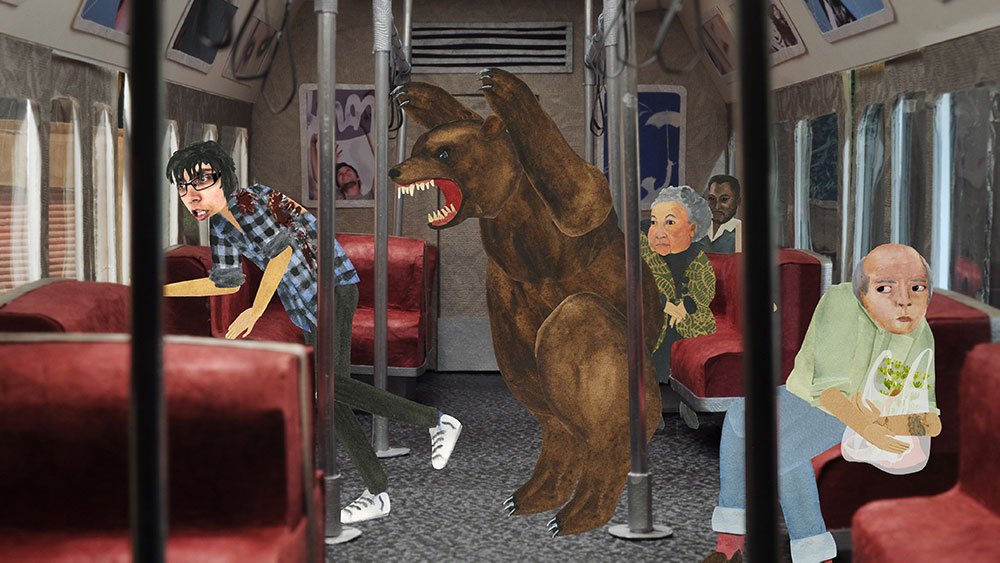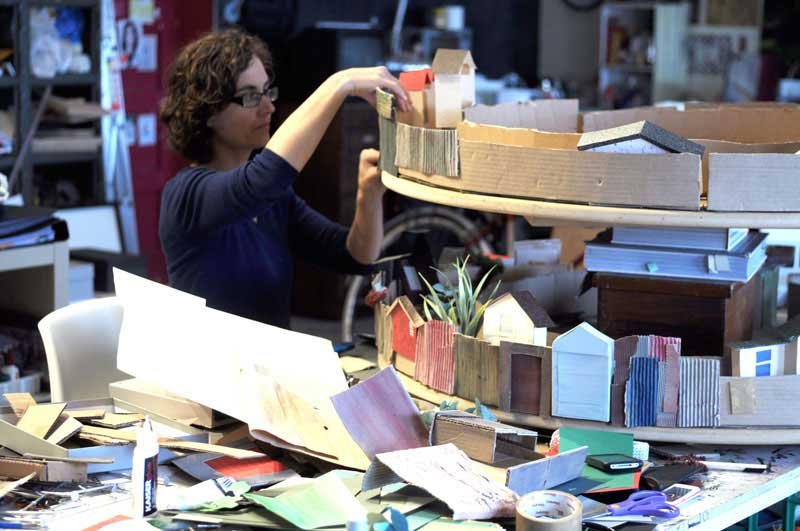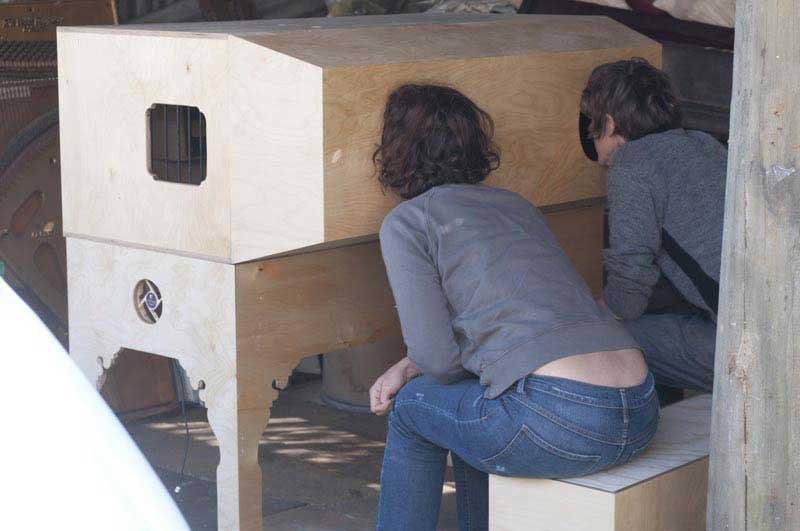
It’s a jungle in here (2011)
Isobel Knowles & Van Sowerwine
with Matthew Gingold
It’s a jungle in here is an interactive installation that explores the boundaries between what’s ok and what’s not in everyday encounters. Two participants become performers in a drama in which they have little control.
-
Award of Distinction, Interactive Art, 2012 Prix Ars Electronica.
-
2020 Take me with you, Artspace at Realm,
Melbourne, Australia2013 Responsibility, Vogele Kultur Zentrum,
Zurich, Switzerland.2013 ISEA, The Rocks,
Sydney, Australia2012 CyberArts 2012, OK Centrum, Part of Festival Ars Electronica.
Linz, Austria.2011 It’s a jungle in here, Screen Space,
Part of the 2011 Melbourne Festival.
Melbourne, Australia -
Written, Directed and Animated by
Isobel Knowles & Van SowerwineInteractivity
Matt GingoldAssistant Programming
Oliver MarriottSound Design
Finn RobertsonCarpentry
Donald RussellSupported by
Australia Council For the Arts
How would you react if someone started behaving inappropriately, or aggressively? Do you try to pretend it isn’t happening, or protest and take action?
As the participants find themselves forced into the role of attacker and victim, a live feed of each participant’s face is placed onto the animated characters, channeling the tensions brought forth as the social compact begins to collapse.
This is the question posed by It’s a jungle in here, an interactive installation that inserts two people into a simulated environment and has them respond to a series of increasingly unsettling encounters.
How it works
It’s a jungle in here is housed in a beautiful hand-made cabinet made by carpenter, Don Russell. In the front of the cabinet are two portholes in which to place your head, and a stool for two participants to sit on.
Participants walk up to the work and place their head in one of the portholes. On a screen inside the cabinet they see a stop-motion animation of a train arriving at a station. Two stop-motion animated paper characters get onto the train, each of which has the live face of each participant fed from a webcam inside the cabinet.
Three stories unroll, one after the other. In each scenario each person is always victim or attacker. One scenario has a man attacking another. The next scene has two schoolgirls mercilessly teasing a man. The third has a man slimily harassing a woman. At the climax of each scenario the attacker transforms into an animal: a bear, two crows or a snake, cathartically venting our shared anxiety through the iconography of ancient fables.
Participants interact with the work using either a button or a microphone. The person playing the attacker presses a large button to continue their actions at various points. The person playing the victim can yell into a microphone, and if they yell as the attacker transforms into an animal they too can transform into a turtle, protecting themselves from the worst of the attacks. At other times yelling produces annoyed or indifferent reactions from other people on the train, adding to the victim’s sense of isolation.
Icons at the side of the screen as well as instructions on the wall help participants understand the interactions required. If only one person is viewing the work the other character takes on an animated painted face.
Other people can view the screen inside through vents on either side of the cabinet—their view is a little obscured and from the side and they can’t look at the person using the work—which gives people waiting their turn a small glimpse of the work without giving away too much.
The user experience
Participants using the work first experience the surprise of seeing their own faces incorporated into the animation. They then often start to act out the appropriate facial expressions to go with the narrative and take great pleasure in participating in the story. The delight of seeing their own faces on various characters with different genders and hairstyles momentarily distracts from the action taking place. As they are drawn into the narrative, however, and realise that they are affecting the story through the use of the button and microphone they become more involved in the action and begin to feel implicated. As the stories reach their climax users become more unsettled and the underlying themes of the narrative content emerge.
Concepts behind the work
It’s a jungle in here explores the relationship that we have with the onscreen persona, reflecting on our online, onscreen selves, as well as our general psycho-physical projected idea of ourselves. The work literally inserts a ‘projection’ of the viewers’ faces into various dramatic scenarios and gives them varying degrees of power over the situation and each other.
The work originally set out to investigate the tension that can develop between two strangers in an enclosed public space such as a train or elevator. As it developed it also became about the potential power we all hold over each other and how easy it is to use both our on-screen and our physical selves to make use of this power without giving much thought to the consequences, both in real-life situations and online, on social networking sites for example.
It’s a jungle in here creates an enticing interface for this power play. To begin with the participants are made to feel comfortable and engaged with the work. Then viewers are drawn into a situation where one is forced to behave oppressively towards the other. The aggressor’s online self invades the personal space of the other by an easy push of a button. The second viewer, the victim, has a microphone with which to interact. Their mode of interaction puts them on a back foot because it takes much more guile to employ, and as in a real life situation they have limited options for avoidance or escape.
The work creates an interesting tension in viewers. For the viewer who plays the role of the victim — at what point do they take full control by walking away from the work, and to what degree do they connect or separate themselves from their onscreen selves? And for the viewer who plays the aggressor, at what point do they begin to feel uncomfortable about the effects of their actions on a virtual character who is simultaneously a real person sitting next to them?
Ultimately, It’s a jungle in here investigates the use of power and how it is exercised to intimidate others both in real life and on-screen. It explores the relationship between our real selves and an on-screen persona that allows us to use and abuse our power. It‘s a jungle in here disrupts the isolation and detachment of this on-screen self by creating an on-screen interaction that is simultaneously a physical interactionwith a living, breathing person who is sitting right next to you.












